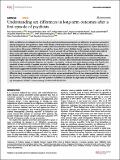Por favor, use este identificador para citar o enlazar a este item:
http://hdl.handle.net/10261/236355COMPARTIR / EXPORTAR:
 SHARE SHARE
 CORE
BASE CORE
BASE
|
|
| Visualizar otros formatos: MARC | Dublin Core | RDF | ORE | MODS | METS | DIDL | DATACITE | |

| Título: | Understanding sex differences in long-term outcomes after a first episode of psychosis |
Autor: | Ayesa Arriola, Rosa; Ortiz-Garcia de la Foz, Victor; Setién-Suero, Esther; Ramírez-Bonilla, María Luz; Suárez-Pinilla, Laura; Mayoral-van Son, Jacqueline; Vázquez-Bourgon, Javier; Juncal Ruiz, María; Gómez Revuelta, Marcos; Tordesillas-Gutiérrez, Diana; Crespo-Facorro, Benedicto CSIC ORCID CVN | Fecha de publicación: | 20-nov-2020 | Editor: | Springer Nature | Citación: | npj Schizophrenia 6: 33 (2020) | Resumen: | While sex differences in schizophrenia have long been reported and discussed, long-term sex differences in outcomes among first episode of psychosis (FEP) patients in terms of the efficacy of Early Intervention Services (EIS) has been an under-explored area. A total of 209 FEP patients (95 females and 114 males) were reassessed after a time window ranging from 8 to 16 years after their first contact with an EIS program (PAFIP) that we will call the 10-year PAFIP cohort. Multiple clinical, cognitive, functioning, premorbid, and sociodemographic variables were explored at 1-year, 3-year and 10-year follow-ups. At first contact, females were older at illness onset, had higher premorbid adjustment and IQ, and were more frequently employed, living independently, and accompanied by a partner and/or children. Existence of a schizophrenia diagnosis, and cannabis and alcohol consumption were more probable among men. During the first 3 years, women showed a significantly better response to minimal antipsychotic dosages and higher rates of recovery than men (50% vs. 30.8%). Ten years later, more females continued living independently and had partners, while schizophrenia diagnoses and cannabis consumption continued to be more frequent among men. Females also presented a lower severity of negative symptoms; however, functionality and recovery differences did not show significant differences (46.7% vs. 34.4%). Between the 3- and 10-year follow-up sessions, an increase in dosage of antipsychotics was observed. These results suggest that the better outcomes seen among women during the first 3 years (while they were treated in an EIS) were in the presence of more favourable premorbid and baseline characteristics. After an average period of 10 years, with the only difference being in negative symptoms course, outcomes for women approximated those of men, drawing particular attention to the increase in dosage of antipsychotic medication once FEP patients were discharged from the EIS program towards community-based services. These findings help to pose the question of whether it is advisable to target sexes and lengthen EIS interventions. | Versión del editor: | http://doi.org/10.1038/s41537-020-00120-5 | URI: | http://hdl.handle.net/10261/236355 | DOI: | 10.1038/s41537-020-00120-5 | Identificadores: | doi: 10.1038/s41537-020-00120-5 e-issn: 2334-265X |
| Aparece en las colecciones: | (IBIS) Artículos |
Ficheros en este ítem:
| Fichero | Descripción | Tamaño | Formato | |
|---|---|---|---|---|
| sex_differences.pdf | 1,2 MB | Adobe PDF |  Visualizar/Abrir |
CORE Recommender
Page view(s)
82
checked on 23-abr-2024
Download(s)
84
checked on 23-abr-2024
Google ScholarTM
Check
Altmetric
Altmetric
Este item está licenciado bajo una Licencia Creative Commons

